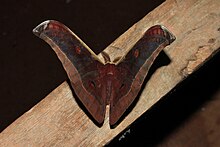
Back এন্থেৰিয়া আছামেনছিছ Assamese মুগা Bengali/Bangla Antheraea assamensis CEB Antheraea assamensis Interlingua Antheraea assamensis Dutch Antheraea assamensis Swedish Antheraea assamensis Vietnamese
| Antheraea assamensis | |
|---|---|

| |
| Adult male, Borneo | |

| |
| Caterpillars | |
| Scientific classification | |
| Domain: | Eukaryota |
| Kingdom: | Animalia |
| Phylum: | Arthropoda |
| Class: | Insecta |
| Order: | Lepidoptera |
| Family: | Saturniidae |
| Genus: | Antheraea |
| Species: | A. assamensis
|
| Binomial name | |
| Antheraea assamensis Helfer, 1837
| |
| Synonyms | |
| |
Antheraea assamensis, known as the muga silkworm as a larva and Assam silk moth as an adult, is a moth of the family Saturniidae. The species was first described by Johann Wilhelm Helfer in 1837. It is found in Assam in northeast India where 99% of its production occurs.[1]
The larvae feed on Cinnamomum, Funastrum (including former Sarcostemma species), Laurus, Litsea, Carpinus, Persea, Magnolia, Michelia, Quercus and Symplocos.
Its silk, one of the varieties of tussar silk, has a glossy golden hue which improves with age and washing. It is never bleached or dyed and is stain resistant. It was reserved for the exclusive use of elites in Assam. Like other silk moths, the female has a larger abdomen and slender antennae when compared to males. The larvae are vibrantly coloured and are monophagous as other silk moths.[2][3]
In 2015, Adarsh Gupta K of Nagaraju's research team at Centre for DNA Fingerprinting and Diagnostics, Hyderabad, India, discovered the complete sequence and the protein structure of muga silk fibroin and published it in Nature Scientific Reports.[4]
In 2009, Utpal Bora and his team at the Indian Institute of Technology Guwahati in Assam reported the potential of using muga silk fibroin as a promising biomaterial for tissue engineering applications.[5]
The disease known as pebrine is caused by Microsporidia (intercellular, fungal parasites), and affects Antheraea assamensis. This destructive disease obstructs the developmental processes of the Muga silkworm.[6]
An article that was published in 2020 talks about a study that was conducted about the moths. The study was that aimed at the cocoons, which were to be collected from 11 different regions of North East Indian regions where they are found. Researchers looked at the weight and silk quality of these cocoons.[7]
- ^ Final Report: Evaluation of Centrally Sponsored Scheme During XI Plan Catalytic Development Programme
- ^ "Organic_Clothing: Raw & Organic Silk: Facts behind the Fibers". Organicclothing.blogs.com. 6 March 2007. Retrieved 18 October 2011.
- ^ "Chapter 9". Fao.org. Archived from the original on 21 October 2012. Retrieved 18 October 2011.
- ^ Adarsh Gupta. K. "Molecular architecture of silk fibroin of Indian golden silkmoth, Antheraea assama".
- ^ "Preparation and characterization of Antheraea assama silk fibroin based novel non‐woven scaffold for tissue engineering applications"
- ^ Subrahmanyam, G., Esvaran, V.G., Ponnuvel, K.M. et al. Isolation and molecular identification of microsporidian pathogen causing nosemosis in Muga silkworm, Antheraea assamensis Helfer (Lepidoptera: Saturniidae). Indian J Microbiol 59, 525–529 (2019). https://doi.org/10.1007/s12088-019-00822-0
- ^ Kalita, Tarali; Dutta, Karabi (2020). "Characterisation of cocoon of different population of Antheraea assamensis (Lepidoptera: Saturniidae)". Oriental Insects. 54 (4). TAYLOR & FRANCIS LTD, 2-4 PARK SQUARE, MILTON PARK, ABINGDON OR14 4RN, OXON, ENGLAND: 574–590. doi:10.1080/00305316.2020.1727376. S2CID 212854982. Retrieved 16 October 2020.